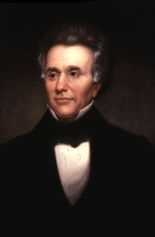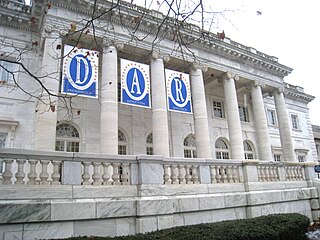Related Research Articles

The National Society Daughters of the American Revolution is a lineage-based membership service organization for women who are directly descended from a patriot of the American Revolutionary War. A non-profit group, the organization promotes education and patriotism. Its membership is limited to direct lineal descendants of soldiers or others of the American Revolution era who aided the revolution and its subsequent war. Applicants must be at least 18 years of age and have a birth certificate indicating that their gender is female. DAR has over 190,000 current members in the United States and other countries. The organization's motto was originally "Home and Country" until the twentieth century, when it was changed to "God, Home, and Country".

Reuben Hyde Walworth was an American lawyer, jurist and politician. Although nominated three times to the United States Supreme Court by President John Tyler in 1844, the U.S. Senate never attempted a confirmation vote. Known for his simplification of equity law in the United States, Walworth served as a chancery judge in New York for more than three decades, including nearly two decades as Chancellor of New York before a new state constitution abolished that highest statewide judicial office. Walworth also ran unsuccessfully for Governor of New York in 1848, and received a commission from the U.S. Supreme Court in 1850 concerning the Wheeling Suspension Bridge.

Jacob Tanner was a Norwegian American Lutheran minister, educator and religious author. He spent most of his life in the United States and became a naturalized citizen.

John Hopwood was an American civil servant during the American Revolutionary War and founded the town of Hopwood, Pennsylvania in western Pennsylvania. John Hopwood was born in Virginia and married Hannah Bearcroft/Barecroft Humphreys, the young widow of Joseph Humphries, in 1770.

Ellen Hardin Walworth was an American author, lawyer, and activist who was a passionate advocate for the importance of studying history and historic preservation. Walworth was one of the founders of the Daughters of the American Revolution and was the organization's first secretary general. She was the first editor of the DAR's official magazine, American Monthly Magazine. In 1893, during a speech at the World's Columbian Exposition, Walworth was one of the first people to propose the establishment of the United States National Archives. Walworth was one of the first women in New York State to hold a position on a local board of education, a role that was frequently used to bolster the call for women's suffrage.

The Saratoga Springs History Museum in Saratoga Springs, New York, United States, is located inside the historic Canfield Casino. The museum's collection focuses on the cultural history of Saratoga Springs.

Flora Adams Darling was an American author. She is primarily noted for playing a role in founding the Daughters of the American Revolution in 1890.

Estelle Emma Doremus was the daughter of Hubbard Skidmore, who served in the American Revolutionary War, and became a charter member and honorary vice president general of the National Society of the Daughters of the American Revolution (DAR). She was a charter officer and regent of the New York City chapter of the DAR between 1892 and 1894. The wife of U.S. chemist Robert Ogden Doremus, she was a leading member of the American community in Paris during the height of the Second French Empire.

The DAR Museum, run by the Daughters of the American Revolution, is an art and history museum in Washington, D.C. The museum is located in Memorial Continental Hall, just down the street from DAR Constitution Hall, where some of the museum's concerts take place.
American Monthly Magazine may refer to:

Eugenia Scholay Washington was an American historian, civil servant, and a founder of the lineage societies, Daughters of the American Revolution and Daughters of the Founders and Patriots of America.

The Tamassee DAR School is a school in Tamassee, South Carolina, founded in 1919 by the Daughters of the American Revolution to serve the underprivileged children of Appalachia. Historic buildings can be observed on the DAR School campus. The school survives and thrives to this day, consistently graduating classes of children between the ages of 7 and 18. The school gymnasium is named after DAR President General May Erwin Talmadge, who redistributed money to the school from the DAR War Fund following the end of World War II.

The Founders of the Daughters of the American Revolution is a sculpture located beside Constitution Hall in Washington, D.C., United States. Dedicated in 1929, during the administration of President General Grace Lincoln Hall Brosseau, the sculpture was created by artist and socialite Gertrude Vanderbilt Whitney in honor of the four founders of the Daughters of the American Revolution (DAR): Mary Desha, Mary Smith Lockwood, Ellen Hardin Walworth, and Eugenia Washington. The sculpture is one of three outdoor artworks in Washington, D.C. by Whitney, the other two being the Titanic Memorial and the Aztec Fountain at the Pan American Union Building.

Catharine H. T. Avery was an American author, editor, and educator of the long nineteenth century. Of Revolutionary ancestry and hailing from Michigan, she was founder and regent of the Western Reserve Chapter of the Daughters of the American Revolution (DAR), of Cleveland, Ohio; Vice-president General of its National Society; and editor of the National Society's official organ, the American Monthly. She also served two years as a member of the Cleveland School Board, being the first woman in Ohio chosen to an elective office.
Wilhelmena Rhodes Kelly was an African-American genealogist who traced her American lineage to the April 5, 1614, union of Pocahontas and John Rolfe. She was also a member of the Jamestowne Society. In 2019 she became the New York State Regent and a member of the National Board of Management, highest ranking woman of color in the National Society Daughters of the American Revolution (NSDAR), since its founding in 1890. She was a pioneer of African-American genealogy. Born and raised in Brooklyn, she was a local Brooklyn historian and member of the Society of Old Brooklynites (SOB), one of the borough's oldest civic organizations. She was the author of books on Bedford-Stuyvesant as well as the Crown Heights and Weeksville sections of Brooklyn, and family genealogy books tracing her family's American roots.

Florence Anderson Clark was an American author, newspaper editor, librarian, and university administrator. She served for 14 years as assistant librarian at the University of Texas (UT), and in honor for her service to the university, she was first woman to have her portrait hung in the university's Main Tower. Clark was affiliated with several organizations, including the Daughters of the American Revolution (D.A.R), Colonial Dames of America, and United Daughters of the Confederacy.

Lynn Forney Young is an American civil leader and clubwoman. She was the 43rd President General of the Daughters of the American Revolution, serving from 2013 to 2016. As the organization's president general, she oversaw a $4 million restoration of DAR Constitution Hall, led the organization in setting a Guinness World Record for "most letters to military personnel collected in one month" with 100,904 letters to members of the United States Armed Forces, and met with Elizabeth II during an event to launch a project to digitize the Royal Archives of George III.

Grace Lincoln Hall Brosseau, also known as Mrs. Alfred J. Brosseau, was an American writer and socialite who served as the 13th president general of the National Society Daughters of the American Revolution from 1926 to 1929.

May Marie Erwin Talmadge was an American civic leader who served as the 19th president general of the Daughters of the American Revolution. She was the first president general of the national society from the U.S. state of Georgia. Her administration led the Daughters of the American Revolution through World War II, donating money and resources to the American Red Cross. She attended the 1945 United Nations Conference of International Organization and was appointed by U.S. president Harry S. Truman to serve on the National Famine Emergency Council.
Doris Pike White was an American businesswoman, investment banker, and civic leader who served as the 24th President General of the Daughters of the American Revolution. Prior to serving as president general, she was the NSDAR State Regent of Maine. White was vice president of the investment firm Pierce, White, and Drummond, Inc. Pike served on the White House Conference on Highway Safety Committee in 1955 and was the only woman appointed to serve on the Maine Judicial Council.
References
- 1 2 "Daughters of the American Revolution, John Rolfe Chapter, Records". The University of Southern Mississippi. Retrieved 22 November 2015.
- ↑ "Full text of "The American monthly magazine"". Archive. 1892. Retrieved 22 November 2015.
- ↑ National Society of the Daughters of the American Revolution: DAR | National Society - Work of the Society - DAR Magazine, http://www.dar.org/natsociety/content.cfm?ID=278&FO=Y&hd=n, Retrieved 5 Jan 2014.
- ↑ National Society, Daughters of the American Revolution: American Spirit magazine, http://www.dar.org/natsociety/magazine.cfm, accessed 5 Jan 2014.
- ↑ Family History Library: American spirit : Daughters of the American Revolution magazine, https://familysearch.org/eng/library/fhlcatalog/supermainframeset.asp?display=titledetails&titleno=1041789&disp=American+spirit%20%20&columns=*,180,0, accessed 5 Jan 2014.
- ↑ Family History Library: Daughters of the American Revolution newsletter : supplement to American Spirit magazine, https://familysearch.org/eng/library/fhlcatalog/supermainframeset.asp?display=titledetails&titleno=1041793&disp=Daughters+of+the+American+Revolution+newsletter, Retrieved 5 Jan 2014.
- ↑ WALWORTH, Ellen Hardin (Oct. 20, 1832–June 23, 1915) (1971) Notable American Women: 1607–1950, Harvard University Press, Cambridge, MA, US. Credo Reference Retrieved 26 March 2010.
- ↑ Western Publishing and Engraving Company 1900, p. 97-98.
Bibliography
 This article incorporates text from this source, which is in the public domain :Western Publishing and Engraving Company (1900). Cyclopedia of Michigan: historical and biographical... by Western Publishing and Engraving Company (New York, New York) Cyclopedia of Michigan: historical and biographical : comprising a synopsis of general history of the state and biographical sketches of men who have, in their various spheres contributed toward its development (Public domain ed.). New York, New York.
This article incorporates text from this source, which is in the public domain :Western Publishing and Engraving Company (1900). Cyclopedia of Michigan: historical and biographical... by Western Publishing and Engraving Company (New York, New York) Cyclopedia of Michigan: historical and biographical : comprising a synopsis of general history of the state and biographical sketches of men who have, in their various spheres contributed toward its development (Public domain ed.). New York, New York.{{cite book}}: CS1 maint: location missing publisher (link)